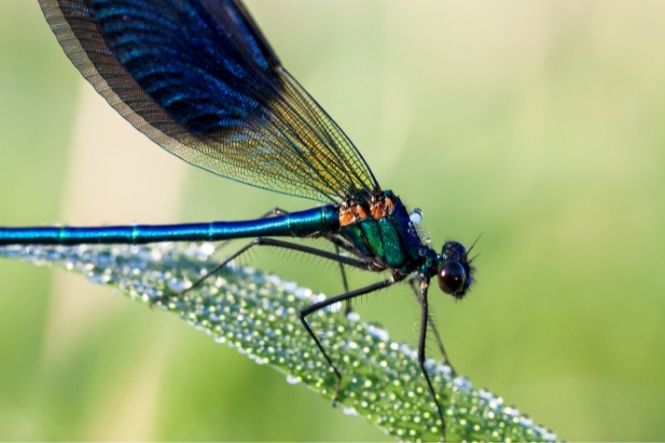There are about 30 species of dragonfly which you may encounter in the UK and Ireland and about 20 species of damselfly. Collectively, they belong to the order of insects termed ‘Odonata’ with dragonflies belonging to the sub order termed ‘Anisoptera’ which means ‘unequal winged’ whilst damselflies belong to the sub order ‘Zygoptera’ – meaning ‘paired wings’. In the summer months when the weather is warmer, both dragonflies and damselflies can often be seen around ponds and other areas of still water, in particular and because of the vast array of colourings across both species, many of them are quite distinctive.
How Do Dragonflies And Damselflies Differ?
To the untrained eye, many people will simply deem any insect which fits the bill to be a dragonfly but it is quite easy to tell dragonflies from damselflies. Dragonflies are bigger with a wingspan that can be 12cm or more. Their back wings are shorter and stubbier than the front pair and when they are resting, they keep their wings outstretched. Dragonflies are also stronger in flight and will often venture away from the water to hunt for food. Their eyes also touch. Damselflies, however, stay close to the water, are smaller than dragonflies and each pair of wings is the same size. They also hold their wings against their bodies when they’re at rest and their eyes are also separate.
How Do They Hunt And What Do They Eat?
Because dragonflies and damselflies both hunt for food during the day, both species of insect rely heavily on eyesight as opposed to touch or smell to catch their prey. They are both carnivorous species and their diets are very similar, relying predominantly on eating mosquitoes or midges although they will eat any small insect. As larvae, they will eat other aquatic larvae and bloodworms. Fortunately for humans, they do not bite or sting.
Natural Predators
Natural predators of both dragonflies and damselflies include insects such as spiders (who snare damselflies in webs), birds and frogs. Their larvae are also at risk from other pond wildlife they share their habitat with such as frogs, newts, fish and kingfishers.
Why They Are Useful
Dragonflies and damselflies serve a couple of extremely useful purposes in terms of environmental research. Because they have tended to emerge earlier on in the spring over recent years and it’s known that they thrive in warmer weather, this can be used as gaining a further insight into patterns of global warming. In addition, as they can only breed in unpolluted water which is rich in oxygen, they are also a good indicator of the presence of clean water.
Common Varieties
Dragonflies fall into 5 distinct family types. All having different names, they are broadly classified into hawkers, chasers, darters, skimmers and emeralds. Damselflies fall into 4 families and their English names often make reference to their colours or the colour of their eyes. Or, alternatively, they might make reference to a particular geographical area of the country where they are most common.
Common dragonflies and damselflies in the UK include:
- Common darter
- Common hawker
- Four-spotted chaser
- Highland darter
- Black-tailed skimmer
- Emerald damselfly
- Northern damselfly
As a wildlife gardener, therefore, it can be quite interesting to get a book containing photographs of the various species of dragonfly and damselfly and to try to identify them in the summer months if you see any hovering around your garden pond.

